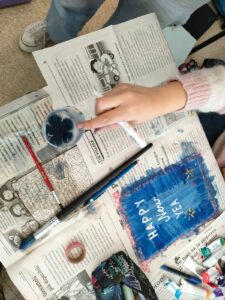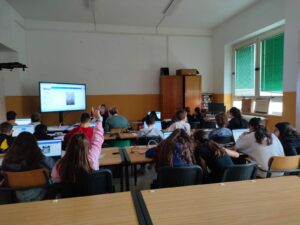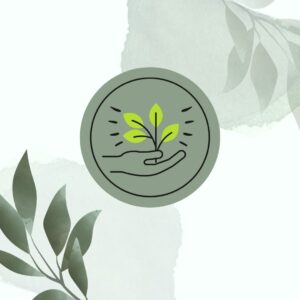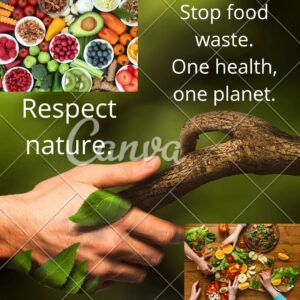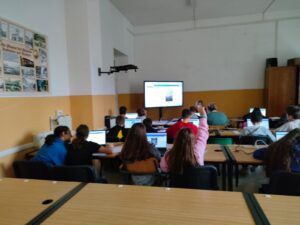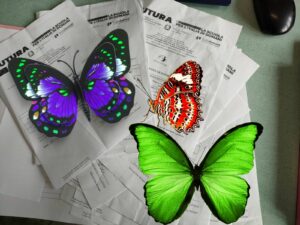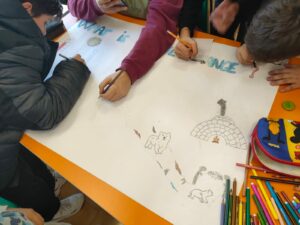SOUNDS OF SUSTAINABILITY (S.O.S)
SOUNDS OF SUSTAINABILITY (S.O.S)
Il tema della sostenibilità ambientale al giorno d'oggi è fondamentale da affrontare. I nostri alunni si sono impegnati in tutte le attività proposte in classe con entusiasmo. Anche le colleghe si sono dimostrate molto collaborative nel lavorare insieme al progetto. Anche l'uso della lingua inglese è stato molto importante per migliorare le loro competenze linguistiche. Lavorare insieme alle colleghe straniere è stato molto piacevole.
The theme of environmental sustainability nowadays is fundamental to address. Our pupils engaged in all the activities proposed in class with enthusiasm. Colleagues also proved to be very cooperative in working together on the project. The use of the English language was also very important in improving their language skills. Working together with foreign colleagues was very pleasant.
Sustainability has been a vital issue for a few decades. Balancing what we need and what future generations need is quite difficult. We should fulfill our needs without compromising the needs of future generations. Life below water or life on land; There should be responsible consumption and production. Sustainability promotes a better world where the is little waste and pollution fewer emissions and more jobs. Through this Project, we will focus on Environmental Sustainability which will help the well-being of societies. Helping our students to be aware of the importance of the conservation of the environment and biodiversity of the planet is our initial goal.
Members: 14
Membership: Turkey(9), Greece(1), Slovakia(1), Portugal(1), Croatia(1), Italy(1)
Age range: 13 - 16
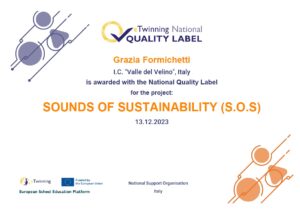
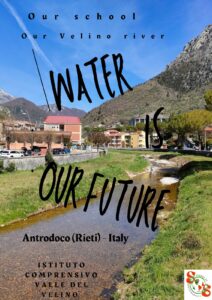
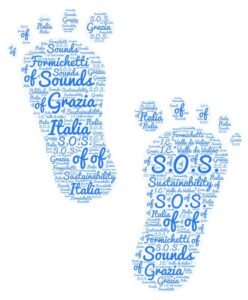
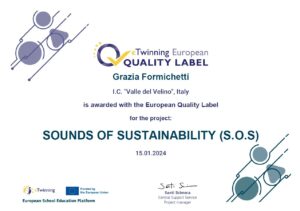
Tales and Traditions of your Country
Project details
Average age of your pupils participating in the project
13
Number of pupils from your class/school participating in the project
24
Type of eTwinning project
An eTwinning project only
A short summary/description of your project (1 paragraph)
The project that I created and to which I dedicated myself all year had the intention of creating a bridge between member countries to make their traditions and stories known to others. We have illustrated the beauties, the territories and everything we love to share them with those who cannot truly know them. It was very exciting to discover how much our Europe can offer us.
Project description
Collaboration between partner schools
Collaboration activities go beyond communication. Please describe the work process of the project clearly outlining the division of tasks between you and your partner(s). In particular, describe:
- a) The aspects of the project where you and your partner(s) collaborated
- b) The activities in which pupils worked together
- c) How the final products of the project were achieved by the pupils
At the beginning, with the other schools, we prepared a logo and a poster to immediately illustrate our countries to others, then we began, according to a timetable, to prepare documents to show traditions and stories to share among the members of the project. At that point we started to put students in contact with each other via email to communicate with each other as pen pals and they responded with great enthusiasm. At that point we began to prepare works together and no longer separately, including exhibitions and image collages. The kids really enjoyed working together with their new friends.They even asked me to meet them and I hope in the future to be able to organize something with my project colleagues for future joint activities in person even outside of this project. It was an experience that touched them greatly, especially in coming into contact with new friends in realities that were new to them and different from their own. An Instagram has been created to allow the contacts established at school through the project and emails to become lasting friendships over time.
Use of technology
Describe:
- a) How technology has been used by all partners to enrich the activities of the project.
- b) How you addressed data-protection and copyright issues
In addition to classic word processing and spreadsheet programs, such as Word and Excel, graphic programs such as Adobe Photoshop, Canva, Paint were used. Furthermore, Artstep was used for the performance. My students especially appreciated the versatile use of Canva which allowed them to unleash their skills from a computer and artistic point of view at the same time. The use of the internet and email, with an important focus on Netiquette, also helped them to get in touch with each other. The use of padlets was also very important for them, especially in the initial phase of developing their personal presentation and getting to know their new foreign friends.
Pedagogical approaches
Describe the following:
- a) The educational objectives and pedagogical approaches you have used with your pupils during the project work. (Examples; small group work, independent research by pupils, etc.
- b) If your pupils are very young, the methods you used to engage them.
The educational objectives and pedagogical approaches used with our students during the project work followed the inclinations and needs of the individuals, so some preferred to work in small groups, while other students chose an independent method. Those who preferred to use IT tools pursued the work in this way to create presentations and other products included in the twinspace and those who instead chose manual skills worked on other projects, such as for example the drawing of the letters for the title collage. Those who were more oriented towards the humanistic branch dedicated themselves more to writing and the acrostic poem. Following these inclinations they worked with more desire and empathy. The pupils who collaborated on the project are mainly pupils in the second and third year of lower secondary school and therefore are on average twelve/thirteen years old, making them very young. No particular method was necessary to involve them because it was enough to simply illustrate the project to them at the beginning to see in their eyes what curiosity had sparked in them. As the work progressed they became so passionate about the project that the only thing I did for them was simply help them develop their ideas. for the rest they have always been free to express themselves according to their own inclinations and aptitudes.
Curricular integration
Describe the following:
- a) How you tried to integrate the project into your existing curriculum/subject matter/s and/or if you followed a multidisciplinary approach.
- b) What key competencies and skills you developed in your pupils during the project work.
The project followed a multidisciplinary approach across the departments that have always been present in our institute organizational chart. In addition to my involvement as a technology teacher and contact person for the project and the Erasmus Commission for our institute, the English language teachers employed by our institute were also fundamental. For this reason, in addition to the graphic-technological ones, linguistic skills and abilities, European citizenship and above all the tendency to learn, based on key European skills, have also been strengthened.
Results and documentation
Describe the impact that this project had on your pupils and on your work as a teacher. In particular:
- a) How you achieved the set of objectives of your project.
- b) How you evaluated your project.
- c) How you disseminated the project and the project outcomes.
The project had a very important impact on my students in terms of personal growth and their awareness as citizens of the world. They were able to deal with realities that were sometimes unknown to them and instead of rejecting such innovations and changes they proved to be open and available towards any aspect unknown to them both from a cultural and religious and social point of view. for this reason my work as a teacher has been significantly enriched. The objectives were fully achieved with minimal effort on my part. The project was evaluated for the children who participated both from the point of view of the learning and from the technological point of view based on the complexity of the work carried out by the individual and personal ability. The project and the results of the project will soon be posted on the school's institutional website to give it wide visibility to everyone and attract new resources for future projects.
Your contributions
Describe your own contribution to the project:
In creating the project with the collaboration of my colleagues I was very happy because it helped me grow professionally and exchange good teaching and pedagogical practices. I found a notable benefit above all in following the personal inclinations of the students without influencing them at all. Above all, it was satisfying to see that students with disabilities or with different problems due to the need for special educational needs really gave a lot to the revival of the project, eliminating their initial difficulties and finding their fulfillment in it. It was really an excellent lesson for me too. This certainly made me want to participate in other projects and always create new ones for my students, as well as for my self-esteem and professional growth.
Dettagli del progetto
Età media dei tuoi alunni che partecipano al progetto
13
Numero di alunni della tua classe/scuola che partecipano al progetto
24
Tipo di progetto eTwinning
Solo un progetto eTwinning
Un breve riassunto/descrizione del tuo progetto (1 paragrafo)
Il progetto che ho ideato e al quale mi sono dedicato tutto l'anno aveva l'intento di creare un ponte tra i paesi membri per far conoscere agli altri le loro tradizioni e storie. Abbiamo illustrato le bellezze, i territori e tutto ciò che amiamo per condividerli con chi non può conoscerli veramente. È stato molto emozionante scoprire quanto la nostra Europa può offrirci.
Esibizione/mostra
Poema acrostico
alfabeto-lettere-dei-nostri-studenti
Amici di penna
Uso della tecnologia
Descrivere:
- a) Come la tecnologia è stata utilizzata da tutti i partner per arricchire le attività del progetto.
- b) Come hai affrontato le questioni relative alla protezione dei dati e al diritto d'autore
Oltre ai classici programmi di elaborazione testi e fogli di calcolo, come Word ed Excel, sono stati utilizzati programmi di grafica come Adobe Photoshop, Canva, Paint. Inoltre, per la performance è stato utilizzato Artstep. I miei studenti hanno particolarmente apprezzato l'uso versatile di Canva che ha permesso loro di dare libero sfogo alle proprie competenze dal punto di vista informatico e artistico allo stesso tempo. Anche l'uso di Internet e della posta elettronica, con un'importante attenzione alla Netiquette, li ha aiutati a entrare in contatto tra loro. Anche l'uso dei padlet è stato molto importante per loro, soprattutto nella fase iniziale di sviluppo della loro presentazione personale e di conoscenza dei nuovi amici stranieri.
Utilizza gli strumenti Web2
presentazioni personali
Approcci pedagogici
Descrivi quanto segue:
- a) Gli obiettivi educativi e gli approcci pedagogici che avete utilizzato con i vostri alunni durante il lavoro del progetto. (Esempi: lavoro in piccoli gruppi, ricerca indipendente da parte degli alunni, ecc.
- b) Se i tuoi alunni sono molto giovani, i metodi che hai utilizzato per coinvolgerli.
Gli obiettivi formativi e gli approcci pedagogici utilizzati con i nostri studenti durante il project work hanno seguito le inclinazioni e le esigenze dei singoli individui, quindi alcuni hanno preferito lavorare in piccoli gruppi, mentre altri studenti hanno scelto un metodo indipendente. Chi ha preferito utilizzare gli strumenti informatici ha proseguito il lavoro in questo modo per creare presentazioni e altri prodotti inseriti nel twinspace e chi invece ha scelto la manualità ha lavorato su altri progetti, come ad esempio il disegno delle lettere per il collage del titolo. Coloro che erano più orientati al ramo umanistico si dedicarono maggiormente alla scrittura e al poema acrostico. Seguendo queste inclinazioni hanno lavorato con più desiderio ed empatia. Gli alunni che hanno collaborato al progetto sono prevalentemente alunni delle seconde e terze classi della scuola secondaria di primo grado e hanno quindi in media dodici/tredici anni, quindi molto giovani. Non è stato necessario alcun metodo particolare per coinvolgerli perché è bastato semplicemente illustrare loro inizialmente il progetto per vedere nei loro occhi quale curiosità aveva suscitato in loro. Man mano che il lavoro andava avanti si appassionarono così tanto al progetto che l'unica cosa che feci per loro fu semplicemente aiutarli a sviluppare le loro idee. per il resto sono sempre stati liberi di esprimersi secondo le proprie inclinazioni e attitudini.
Integrazione curriculare
Descrivi quanto segue:
- a) Come hai cercato di integrare il progetto nel tuo curriculum/argomento/i esistente/i e/o se hai seguito un approccio multidisciplinare.
- b) Quali competenze e abilità chiave hai sviluppato nei tuoi alunni durante il lavoro del progetto.
Il progetto ha seguito un approccio multidisciplinare tra i dipartimenti da sempre presenti nell'organigramma del nostro istituto. Oltre al mio coinvolgimento come docente di tecnologia e referente del progetto e della Commissione Erasmus per il nostro istituto, fondamentali sono stati anche i docenti di lingua inglese impiegati dal nostro istituto. Per questo, oltre a quelle grafico-tecnologiche, sono state rafforzate anche competenze e abilità linguistiche, cittadinanza europea e soprattutto la tendenza ad apprendere, sulla base delle competenze chiave europee.
Risultati e documentazione
Descrivi l'impatto che questo progetto ha avuto sui tuoi alunni e sul tuo lavoro di insegnante. In particolare:
- a) Come hai raggiunto gli obiettivi del tuo progetto.
- b) Come hai valutato il tuo progetto.
- c) Come avete diffuso il progetto e i risultati del progetto.
Il progetto ha avuto un impatto molto importante sui miei studenti in termini di crescita personale e di consapevolezza come cittadini del mondo. Hanno saputo confrontarsi con realtà a volte sconosciute e invece di rifiutare tali innovazioni e cambiamenti si sono dimostrati aperti e disponibili verso qualsiasi aspetto a loro sconosciuto sia dal punto di vista culturale che religioso e sociale. per questo motivo il mio lavoro di insegnante si è notevolmente arricchito. Gli obiettivi sono stati pienamente raggiunti con il minimo sforzo da parte mia. Il progetto è stato valutato per i bambini che hanno partecipato sia dal punto di vista dell'apprendimento che dal punto di vista tecnologico in base alla complessità del lavoro svolto dalle capacità individuali e personali. Il progetto e i risultati del progetto saranno presto pubblicati sul sito istituzionale della scuola per dargli ampia visibilità a tutti e attrarre nuove risorse per progetti futuri.
I tuoi contributi
Descrivi il tuo contributo al progetto:
Nel realizzare il progetto con la collaborazione dei miei colleghi sono stato molto contento perché mi ha aiutato a crescere professionalmente e a scambiare buone pratiche didattiche e pedagogiche. Ho trovato un notevole beneficio soprattutto nel seguire le inclinazioni personali degli studenti senza influenzarli minimamente. Soprattutto è stato soddisfacente vedere che gli studenti con disabilità o con problematiche diverse dovute alla necessità di bisogni educativi speciali hanno dato davvero molto al rilancio del progetto, eliminando le loro difficoltà iniziali e trovando in esso la loro realizzazione. Anche per me è stata davvero un'ottima lezione. Questo sicuramente mi ha fatto venire voglia di partecipare ad altri progetti e crearne sempre di nuovi per i miei studenti, oltre che per la mia autostima e crescita professionale.
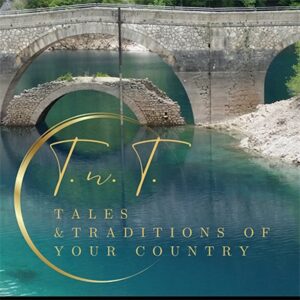
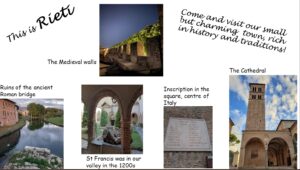
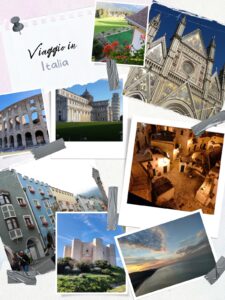
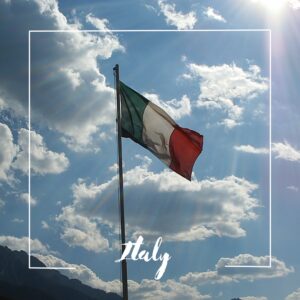
E-TWINNING Project
Type of the Project : eTwinning
The name of the Project : Respect Food and Nature
Coordinator School : Seyhan Gazi Anatolian High School –Adana –Turkiye
Partners of the Project : Turkiye(8), Czechia(2), Italy(2), Portugal(1), Serbia(1), Greece(1)
|
Esen Işık Coşanay |
Gazi Anatolian High School –Adana –Turkiye (Founder ) |
| Romana Svestkova | ZS A MS School Jistebnice Secondary school Jistebnice
Jistebnice,Czech Republic (Co-founder) |
| Filiz Taşçı | Tevfik İleri Anatolian High School –Erzurum –Turkiye |
| Berna Çetin | Arif Nihat Asya Anatolian High School-Adana –Turkiye |
| Ummuhan Endamlı | Sabahattin Zaim Social Sciences High School-Gaziantep-Turkiye |
| Michaela Široká | Základní škola a Mateřská škola Jistebnice-Czechia |
| Maria Bourgou | Eniaio Eidiko Epaggelmatiko Gymnasio Lykeio I.N.A.A. Pefkon , Thessaloniki –Greece |
| Grazia Formichetti | Istituto Comprensivo “Valle del Velino “Cittaducale, Rieti, Italia |
| Serdar Ördem | Adasokağı Anatolian High School – Adana-Turkiye
|
| Alessandra Moroni | Istituto Comprensivo “Valle del Velino “Cittaducale, Rieti, Italia |
| Azime Büyükfidan | Sabancı Vocational and Technical Anatolian high school Adana-Turkiye |
| Aslı Türkmen | Karatay Toki Anadolu Lisesi-Konya-Turkiye |
| Mevlüde Ceran | Şarkışla İsmet Yılmaz Science High School-Sivas -Turkiye |
| Sonia Riberio | AE Caldas de Vizela, Portugal |
| Miroslav Raus (Observer) | Os "Matija Gubec" Serbia |
Starting Idea of the Project : “Mevlana “Our Inspirator
We are inspired by Mevlana because of his tolerance and respect to everything in the world. By following his Sufi philosophy ,we are aiming at respecting food and nature .
Aims of the Project :
-The participants will learn important issues such as climate-friendly choices (fashion or not) that they should make in their daily lives,awareness of water and food waste and etc... -Participants will improve the climate situation in the world with a greener and 'healthier' kitchen and apply ' Climate-friendly kitchen rules. -Participants will reduce their own climate footprint and gain better knowledge of which area they should focus on and learn more about the wasting food negative effects to our planet, In order to leave as small a footprint as possible when the participants buy food LOCALY, they will gradually adapt shopping and eating habits. -Having learned the connection between sufism, climate-friendly kitchen, sustainable living, participants will be CLIMATE ACTIVIST.
Target Group : 13-17 age
Expected Results : The target group of our project is actually people of all ages so we will carry out this project with more students, parents and teachers at schools. The project team determined that our target group should learn about the link between climate and food. The students are needed to do research collaboratively, help manage the project process, research the people and events they can see in daily life,make applications together in the kitchen,have information about climate-related areements such as the Paris and Kyoto Agreements.With this project, we will highlight the creativity, imagination, cooperation and teamwork of the participants, and we will give them homework for the solutions of the climate crisis, which needs to be solved on its own, as we are aware that problem-solving skills are among the abilities that students should have to solve complex problems both today and in the future. Leadership, on the other hand, will be prioritized in all the activities we will carry out in our project because leadership has been one of the greatest qualities that the participants should have and it is a skill that the participants need in their lives.
Progetto E-TWINNING
Tipo di progetto: eTwinning
Il nome del Progetto: Rispetto del Cibo e della Natura
Coordinatore della scuola: Seyhan Gazi Anatolian High School –Adana –Turkiye
Partner del progetto: Turkiye(8), Repubblica Ceca(2), Italia(2), Portogallo(1), Serbia(1), Grecia(1)
|
Esen Işık Coşanay |
Gazi Anatolian High School –Adana –Turkiye (Founder ) |
| Romana Svestkova | ZS A MS School Jistebnice Secondary school Jistebnice
Jistebnice,Czech Republic (Co-founder) |
| Filiz Taşçı | Tevfik İleri Anatolian High School –Erzurum –Turkiye |
| Berna Çetin | Arif Nihat Asya Anatolian High School-Adana –Turkiye |
| Ummuhan Endamlı | Sabahattin Zaim Social Sciences High School-Gaziantep-Turkiye |
| Michaela Široká | Základní škola a Mateřská škola Jistebnice-Czechia |
| Maria Bourgou | Eniaio Eidiko Epaggelmatiko Gymnasio Lykeio I.N.A.A. Pefkon , Thessaloniki –Greece |
| Grazia Formichetti | Istituto Comprensivo “Valle del Velino “Cittaducale, Rieti, Italia |
| Serdar Ördem | Adasokağı Anatolian High School – Adana-Turkiye
|
| Alessandra Moroni | Istituto Comprensivo “Valle del Velino “Cittaducale, Rieti, Italia |
| Azime Büyükfidan | Sabancı Vocational and Technical Anatolian high school Adana-Turkiye |
| Aslı Türkmen | Karatay Toki Anadolu Lisesi-Konya-Turkiye |
| Mevlüde Ceran | Şarkışla İsmet Yılmaz Science High School-Sivas -Turkiye |
| Sonia Riberio | AE Caldas de Vizela, Portugal |
| Miroslav Raus (Observer) | Os "Matija Gubec" Serbia |
Idea iniziale del progetto: “Mevlana” Il nostro ispiratore
Ci ispiriamo a Mevlana per la sua tolleranza e rispetto verso tutto nel mondo. Seguendo la sua filosofia Sufi, miriamo a rispettare il cibo e la natura.
Obiettivi del progetto:
-I partecipanti impareranno questioni importanti come le scelte rispettose del clima (moda o meno) che dovrebbero fare nella loro vita quotidiana, la consapevolezza dello spreco di acqua e cibo, ecc... -I partecipanti miglioreranno la situazione climatica nel mondo con un una cucina più verde e “sana” e applicare le “regole della cucina rispettose del clima”. -I partecipanti ridurranno la propria impronta climatica e acquisiranno una migliore conoscenza di quale area dovrebbero concentrarsi e impareranno di più sugli effetti negativi dello spreco di cibo sul nostro pianeta. Al fine di lasciare un'impronta quanto più piccola possibile quando i partecipanti acquistano cibo LOCALMENTE, adatterà gradualmente le abitudini di acquisto e di alimentazione. -Avendo appreso la connessione tra sufismo, cucina rispettosa del clima e vita sostenibile, i partecipanti saranno ATTIVISTI DEL CLIMA
Gruppo target: 13-17 anni
Risultati attesi: Il gruppo target del nostro progetto è in realtà costituito da persone di tutte le età, quindi realizzeremo questo progetto con più studenti, genitori e insegnanti nelle scuole. Il team del progetto ha stabilito che il nostro gruppo target dovrebbe conoscere il legame tra clima e cibo. Gli studenti sono tenuti a svolgere ricerche in modo collaborativo, aiutare a gestire il processo del progetto, ricercare le persone e gli eventi che possono vedere nella vita quotidiana, presentare applicazioni insieme in cucina, avere informazioni su aspetti legati al clima come gli accordi di Parigi e Kyoto. questo progetto, metteremo in risalto la creatività, l'immaginazione, la cooperazione e il lavoro di squadra dei partecipanti, e assegneremo loro dei compiti per le soluzioni della crisi climatica, che deve essere risolta da sola, poiché siamo consapevoli che le capacità di problem solving sono tra le abilità che gli studenti dovrebbero avere per risolvere problemi complessi problemi sia attuali che futuri. La leadership, d'altra parte, avrà la priorità in tutte le attività che svolgeremo nel nostro progetto perché la leadership è stata una delle più grandi qualità che i partecipanti dovrebbero avere ed è un'abilità di cui i partecipanti hanno bisogno nella loro vita.
